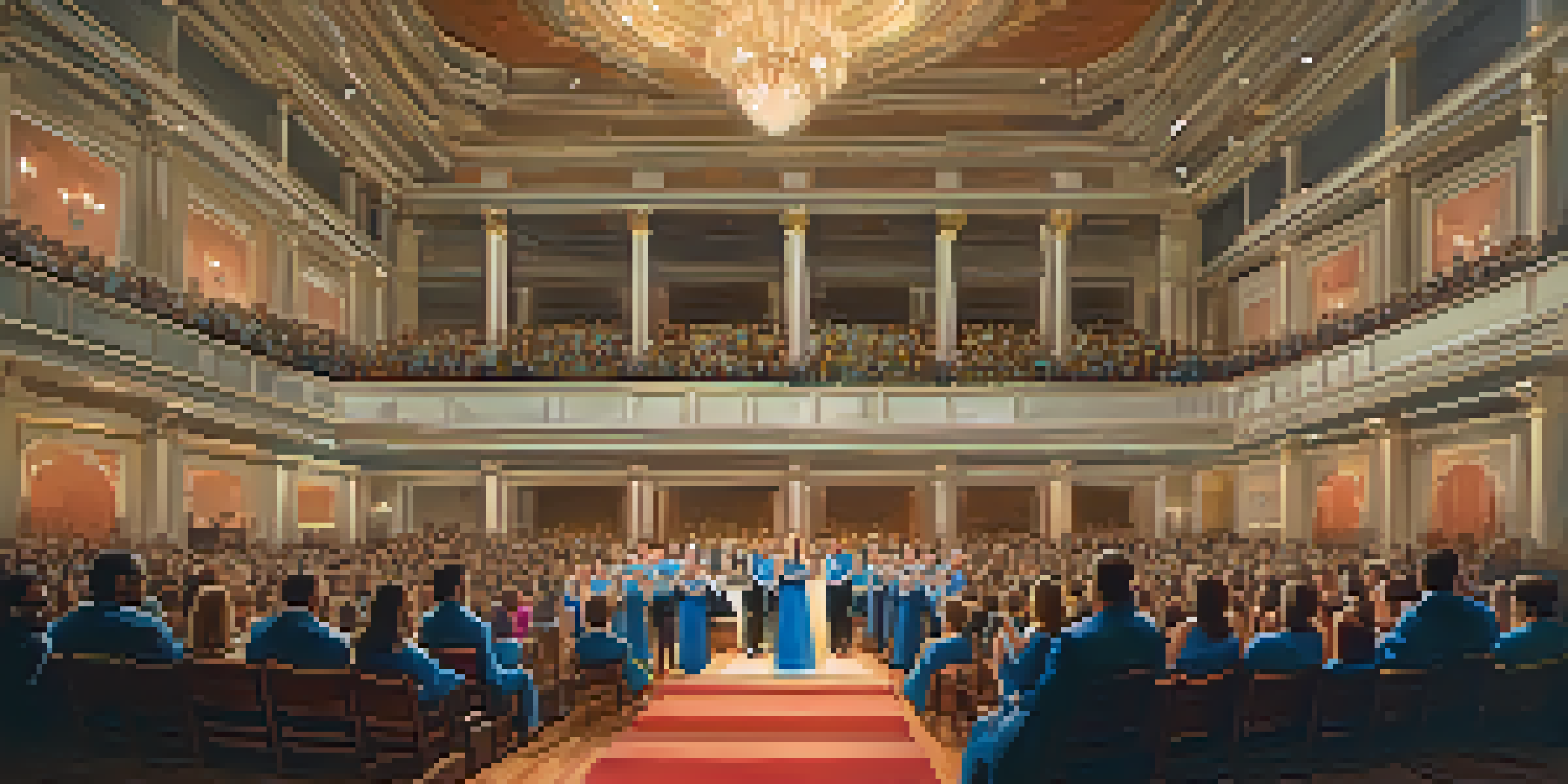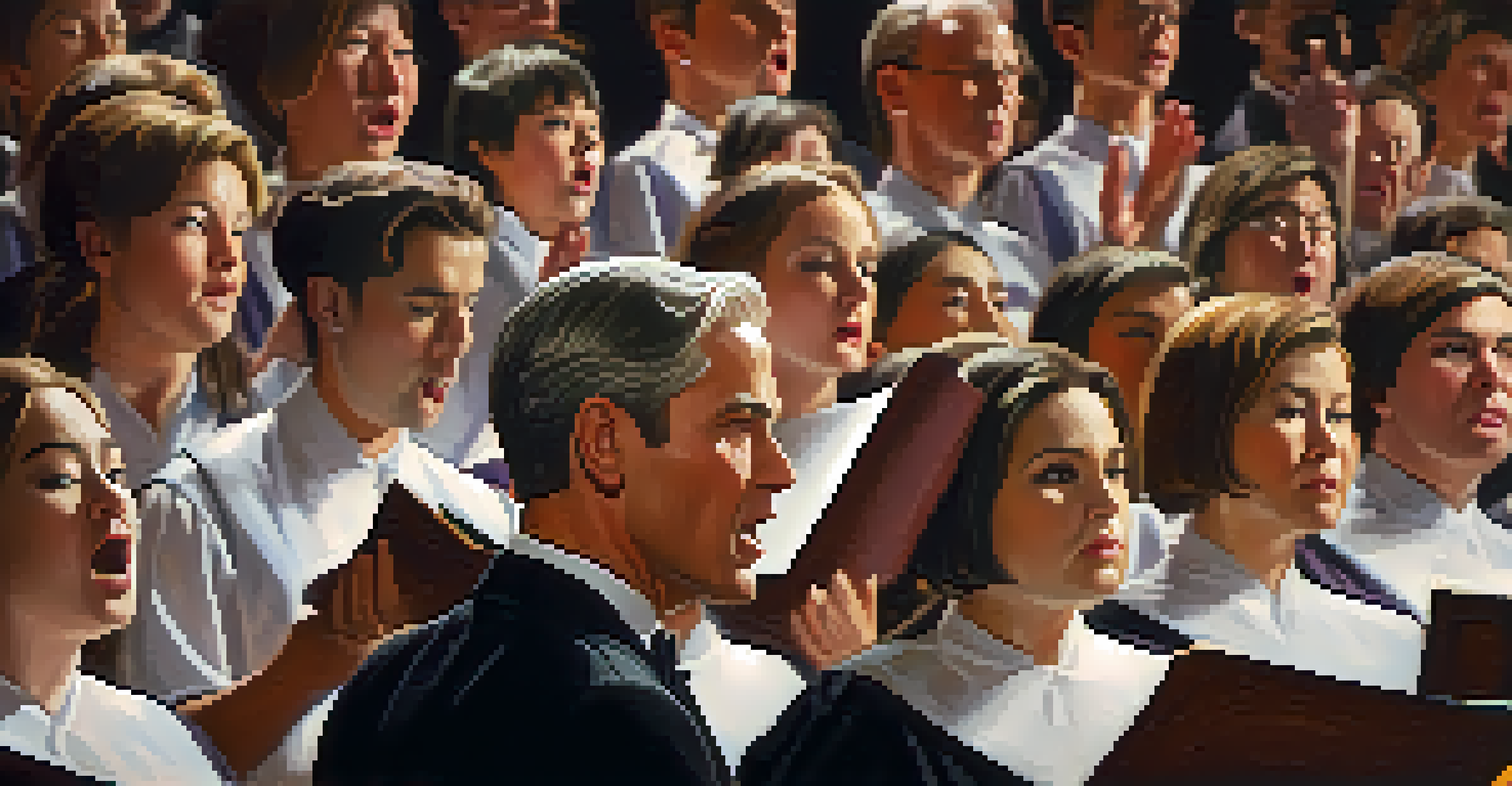Analyzing Choral Music: Structure, Harmony, and Textures

Understanding Choral Music Structure: The Framework
Choral music structure serves as the backbone of a composition, guiding musicians through its various sections. Typically, choral works are organized into movements or sections that may include verses, choruses, and bridges. This organization not only helps performers know when to sing but also assists in conveying the piece's emotional journey.
Choral music is the ultimate expression of community, blending individual voices into a harmonious whole.
Consider a well-known choral work like Handel's 'Messiah', which is divided into distinct parts that each contribute to the overarching theme. This structure allows for dynamic shifts in mood and intensity, keeping the audience engaged. Understanding this framework is essential for both performers and listeners, as it sets the stage for the musical narrative.
By analyzing the structural components of choral music, we can better appreciate how composers craft their pieces. Each section plays a role in building tension or providing resolution, making the overall experience more fulfilling. This awareness enriches our listening experience and deepens our connection to the music.
The Role of Harmony in Choral Music: Creating Depth
Harmony in choral music acts like the colors on an artist's palette, adding depth and emotion to the performance. When voices blend together, they create a rich tapestry of sound that can evoke various feelings, from joy to melancholy. Choral harmonies often feature multiple vocal parts, such as soprano, alto, tenor, and bass, which interweave to form intricate layers.

For instance, in a piece like 'Ave Verum Corpus' by Mozart, the harmonic interplay between the different voice types enhances the overall beauty of the music. This complexity makes each performance unique, as singers interpret the harmonies differently based on their own experiences. Understanding harmony allows us to appreciate the craftsmanship behind choral compositions.
Choral Structure Guides Emotion
Understanding the structure of choral music, like movements and sections, enhances both performance and appreciation of its emotional journey.
Moreover, harmony can also signify the emotional climax of a piece, guiding listeners through its highs and lows. By analyzing how harmonies shift throughout a composition, we discover the underlying emotional narrative that the composer intended. This exploration opens our ears to the subtleties of choral music, making each listen a new adventure.
Textures in Choral Music: Weaving Voices Together
Texture in choral music refers to how different vocal lines interact and complement each other, creating a cohesive sound. Choral textures can range from monophonic, where all voices sing the same melody, to polyphonic, where multiple independent melodies coexist. This variety adds richness and complexity to the musical experience.
Music is the shorthand of emotion.
A great example of textural variety can be found in the works of J.S. Bach, particularly in his motets. Bach often employed intricate counterpoint, where independent vocal lines weave together to form a harmonious whole. This technique not only showcases each voice's individuality but also highlights how they contribute to the collective sound.
By examining the textures present in a choral piece, we gain insights into the composer's intentions and the emotional impact of the music. A rich texture can create a sense of fullness, while a thinner texture might evoke feelings of intimacy. Understanding these nuances helps us appreciate the artistry involved in choral music.
Analyzing Lyrics: The Emotional Core of Choral Music
The lyrics in choral music often serve as the emotional heart of the piece, conveying messages that resonate with audiences. Many choral works are based on religious texts, poetry, or historical narratives, adding layers of meaning to the music. By analyzing the lyrics, we can uncover the themes and emotions that a composer wishes to express.
Take, for example, the famous 'Hallelujah' chorus from Handel's 'Messiah'. The text, which exalts joy and triumph, is mirrored by the exuberant musical setting. By understanding the relationship between the lyrics and the music, we can appreciate how they work together to create a powerful emotional impact.
Harmony Adds Depth to Sound
The interplay of different vocal parts in choral music creates rich harmonies that evoke a wide range of emotions, enriching the listening experience.
Furthermore, the interpretation of lyrics can vary based on cultural and historical contexts, enriching our understanding of a piece. When we delve into the meaning behind the words, we connect more deeply with the music and experience it on a personal level. This analysis allows us to appreciate choral music as a multifaceted art form.
The Influence of Historical Context on Choral Music
Historical context plays a vital role in shaping choral music, influencing its structure, style, and themes. Different musical periods, such as the Renaissance, Baroque, or Romantic, brought unique characteristics to choral compositions. Understanding this context helps us appreciate the evolution of choral music over time.
For instance, Renaissance choral music often emphasized polyphony, which allowed multiple independent melodies to coexist beautifully. In contrast, the Baroque period saw composers like Bach introducing more complex harmonies and counterpoint. By examining these historical shifts, we can better grasp the progression of musical ideas and techniques.
Additionally, social and cultural factors can influence the themes explored in choral music. For example, many choral works from the Romantic era reflected the emotional struggles and aspirations of the time. By analyzing the historical context, we can uncover the motivations behind the music and gain a deeper understanding of its significance.
Performance Practices: Bringing Choral Music to Life
Performance practices are essential for bringing choral music to life, as they encompass the techniques and interpretations used by singers. These practices can vary significantly based on the era, style, and even the individual ensemble. Understanding performance practices helps singers deliver a more authentic and engaging interpretation of a piece.
For instance, early music ensembles often focus on historically informed performance, using period instruments and vocal techniques to recreate the sound of the time. This approach can drastically alter how a piece is perceived, allowing listeners to experience music in its original context. By exploring these practices, we can appreciate the nuances that different interpretations bring to choral music.
Historical Context Shapes Composition
The evolution of choral music is influenced by historical periods and cultural factors, which inform its structure, style, and themes.
Moreover, conductor interpretations play a crucial role in shaping the performance. A conductor’s vision can influence dynamics, phrasing, and tempo, offering a unique take on a well-known piece. This collaboration among singers and conductors highlights the importance of communication and interpretation, making every performance a unique experience.
The Future of Choral Music: Innovations and Trends
The future of choral music is bright and promising, marked by innovations and trends that continue to evolve the genre. With advances in technology, we see new ways of composing, performing, and sharing choral music. These developments not only broaden the scope of choral music but also attract diverse audiences.
For instance, virtual choirs have gained popularity, allowing singers from around the world to collaborate and perform together, despite physical distances. This trend has opened up new avenues for creativity and expression, showcasing the power of technology in music. As more composers explore contemporary themes and genres, the richness of choral music continues to expand.

Additionally, there is a growing emphasis on inclusivity and diversity within choral music, with more composers drawing from a variety of cultural backgrounds. This trend enriches the repertoire and ensures that choral music remains relevant and reflective of our diverse society. By embracing these innovations, we look forward to a vibrant future for choral music.